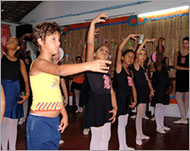Dancing and dreaming in Rio’s slums
Children growing up in Rio de Janiero’s favelas, or slums, may be traumatised by drugs and violence, but a ballet school is giving them hope of a better life.

In a small white building in the Rio de Janeiro neighbourhood of Santa Teresa, a parade of eager young girls don their pink ballet shoes and stockings and pirouette to the music of Elgar and Tchaikovsky, briefly shutting out the sound of gun shots and violence outside.
The school has been nominated for the national Causos do Eca award which recognises outstanding work with children and adolescents.
The projectl’s genesis can be traced to an innocent question by a four year old.
Lais Santo de Oliveira, now 13, approached ballet teacher Vania Farias Queiroz at a school Queiroz was visiting.
“I asked her when she was going to give lessons to me,” says Lais.
Stumped
Queiroz, 36, a professional ballet dancer for the past 20 years and who had only ever given classes to Rio’s elite, was stumped by the question.
 |
|
Young boys from the favela also |
“I had never been in a favela in my life and when I discovered that Lais lived there I offered myself as a volunteer to give lessons,” Queiroz tells Aljazeera.net
But her family expressed concern because she could easily be kidnapped, held for ransom, or mugged in the drug-infested favela.
Routinely, children would come across the corpses of gang members killed in the ongoing drug trafficking turf wars.
“Today there is a situation of war there with different factions trying to invade all the time, one fighting with another but the will to give that lesson was greater,” she says.
Queiroz approached the Residents Association of Morro da Coroa, the favela young Lais lived in and offered to give free ballet lessons.
The first makeshift ballet classroom was without windows, and holes in the roof allowed rain in. The chairs were all broken. In the centre of the room was a mud-filled ditch covered over by wooden planks.
But Queiroz was determined.
“I was used to giving lessons to the middle and upper classes and it was a completely new reality. But I soon realised that the children in the favela and the middle class children are equal – they are all children,” she says.
Against the odds
Lais says she braved a shootout between gangs that suddenly erupted as she walked to her first lesson.
 |
|
The streets of Rio de Janeiro‘s |
“My house is not very big and the favela is violent. It’s not good to live there. I’m very afraid to live there. Sometimes when there is a shootout we don’t have a place to run to. It’s horrible,” she tells Aljazeera.net.
But from 12 students in a crowded room on the first day to 40 within the first three months, Queiroz’s school has grown to accommodate 150 in a larger classroom.
The students come from all eight favelas surrounding the Santa Teresa neighbourhood.
Over the years, the school has earned recognition for merging studies with such extracurricular pursuits as culture and dance.
The school, which is entirely run by volunteers and with just one ballet teacher, also provides instruction in the history of art, dance and music together with up to 12 other disciplines.
Pursuing their dreams
And the results have been startling – there is zero pregnancy among the 150 students who range from three to 17 – a rare achievement given the high teen pregnancy rate in Rio de Janeiro.
The success of the school in atttracting children away from the violence of the streets and giving them something to hope for inspired Queiroz to abandon other pursuits and dedicate herself full-time to her ballet school in Santa Teresa.
 |
|
Queiroz (back) says Lais changed |
“Lais changed my life by trying to convince me to help her realise her dreams,” Queiroz says.
More than 750 children like Lais have been taught ballet since 1999.
And although Lais does not want to be a professional dancer, she says ballet has changed her life, given her self-esteem and taught her to aim high. She says she wants to study to become a doctor or a human rights worker.
“I always had dreams and my teacher showed us that we should never give them up. Now I think ‘I can do it’, fulfilling your dreams is possible,” she says.